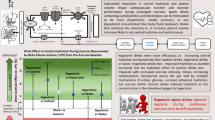Summary
Reports from the literature and our own data on red cell 2,3-DPG and its importance for unloading O2 from Hb to the tissues during exhaustive exercise are contradictory. We investigated red cell metabolism during incremental bicycle ergometry of various durations. Furthermore changes in blood composition occurring during exercise were simulated under in vitro conditions. The effect of a moderate (11.2 mmol · l−1 lactate, pH=7.127) and severe (18 mmol · l−1 lactate, pH=6.943) lactacidosis on red cell 2,3-DPG concentration was compared with the effect of similar acidosis induced by HCl. Our data indicate that the concentration of 2,3-DPG in red cells depends on the degree of lactacidosis, but not on the duration of exercise. During moderate lactacidosis red cell 2,3-DPG remains unchanged. This can be explained by an interruption of red cell glycolysis on the PK and GAP-DH step caused by a lactate and pyruvate influx into the erythrocyte, as well as an intraerythrocytic acidosis and a drop in the NAD/NADH ratio. During severe lactacidosis and HCL-induced acidosis a decrease in 2,3-DPG due to an inhibition of 2,3-DPGmutase and other glycolytic enzymes can be found. Mathematical correction of the observed P-50 value for the decrease in 2,3-DPG occurring during severe lactacidosis showed that a decrease in Hb-O2-affinity during strenuous exercise depends on the degree of lactacidosis and temperature elevation.
Similar content being viewed by others
References
Bellingham AJ, Detter JC, Lenfant C (1971) Regulatory mechanisms of hemoglobin oxygen affinity in acidosis and alkalosis. J Clin Invest 50:700–706
Beutler E (1975) Red cell metabolism. Grune & Stratton, New York, San Franzisco, London
Böning D, Schweigart U, Tibes U, Hemmer B (1975) Influences of exercise and endurance training on the oxygen dissociation curve of blood under in vivo and in vitro conditions. Eur J Appl Physiol 34:1–10
Böning D, Skipka W, Heedt P, Jenker W, Tibes U (1979) Effects and post-effects of two-hour exhausting exercise on composition and gas transport functions of blood. Eur J Appl Physiol 42:117–123
Böswart J, Kuta I, Lisy Z, Kostiuk P (1980) 2,3-diphosphoglycerate during exercise. Eur J Appl Physiol 43:193–199
Braumann KM, Böning D, Trost F (1979) Oxygen dissociation curves in trained and untrained subjects. Eur J Appl Physiol 42:51–60
Deuticke B, Beyer E, Forst B (1982) Discrimination of three parallel pathways of lactate transport in the human erythrocyte membrane by inhibitors and kinetic properties. BBA 684:96–110
Dill D, Graybiel A, Hurtado A, Taquini AC (1940) Der Gasaustausch in der Lunge im Alter. Z Altersforschung 2:20–33
Dubinsky WP, Racker E (1978) The mechanism of lactate transport in human erythrocytes. J Membr Biol 44:25–36
Jacobasch G, Minakami S, Rapoport SM (1974) Glycolysis of the erythrocyte. In: Yoshikawa H, Rapoport SM (ed) Cellular and molecular biology of erythrocytes. Urban & Schwarzenberg, München Berlin Wien
Katz A, Sharp RL, King DS, Costill DL, Fink WJ (1984) Effect of high intensity interval training on 2,3-diphosphoglycerate at rest and after maximal exercise. Eur J Appl Physiol 52:331–335
Kiener PA, Massaras ChV, Westhead EW (1979) Phosphorylation and inhibition of human erythrocyte pyruvate kinase by an erythrocyte membrane cAMP dependent proteinkinase. Biochem Biophys Res Com 91:50–55
MairbÄurl H, Humpeler E (1981) The influence of adrenaline on the metabolism of erythrocytes in vitro. Biochem Soc Transactions 9:99–100
MairbÄurl H, Schobersberger W, Schwaberger G, Tanaka KR (1984) Effects of duration of exercise on red cell metabolism and oxygen transport. Pflügers Arch 402:R14
MairbÄurl H, Hasibeder W, Schobersberger W, Schwaberger G (1985) Adaptation of red cell function to acute exercise. Pflügers Arch 403:R71
Meen HD, Holter PH, Refsum HE (1981) Changes in 2,3-diphosphoglycerate (2,3-DPG) after exercise. Eur J Appl Physiol 46:177–184
Minakami S, Yoshikawa H (1966) Studies on erythrocyte glycolysis III. J Biochem 59:145–150
Ramsey JM, Pipoly Jr SW (1979) Response of erythrocytic 2,3-diphosphoglycerate to strenuous exercise. Eur J Appl Physiol 40:227–233
Rapoport I, Berger H, Eisner R, Rapoport SM (1977) pH-de-pendent changes of 2,3-bisphosphoglycerate. Acta Biol Med Germ 36:515–521
Rapoport S (1968) The regulation of glycolysis in mammalian erythrocytes. Essays Biochem 4:69–103
Rasmussen H, Lake W, Allen JE (1975) The effect of catecholamines and prostaglandins upon human and rat erythrocytes. BBA 411:63–73
Remes K, Vuopio P, HÄrkönen M (1979) Effect of long term training and acute physical exercise on red cell 2,3-diphosphoglycerate. Eur J Appl Physiol 42:199–207
Sachs L (1973) Angewandte Statistik. Springer, Berlin Heidelberg New York
Schwaberger G, Pessenhofer H, MairbÄurl H, Humpeler E (1982) Changes of parameters influencing the oxygen affinity of hemoglobin during exercise. Kongressbd Dtsch SportÄrztekongress, Köln
Taunton JE, Taunton CA, Banister EW (1974) Alterations in 2,3-DPG and P-50 with maximal and submaximal exercise. Med Sci Sports 6:238–241
Author information
Authors and Affiliations
Rights and permissions
About this article
Cite this article
MairbÄurl, H., Schobersberger, W., Hasibeder, W. et al. Regulation of red cell 2,3-DPG and Hb-O2-affinity during acute exercise. Europ. J. Appl. Physiol. 55, 174–180 (1986). https://doi.org/10.1007/BF00715001
Accepted:
Issue Date:
DOI: https://doi.org/10.1007/BF00715001




